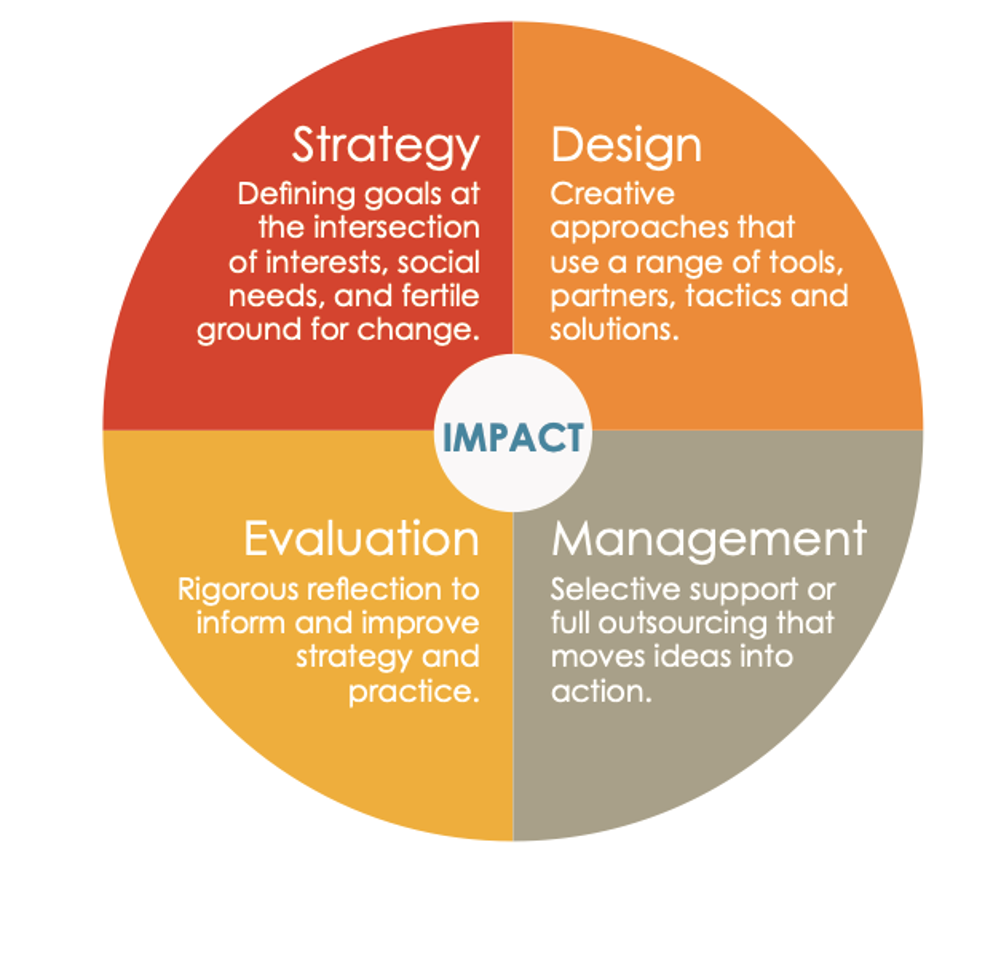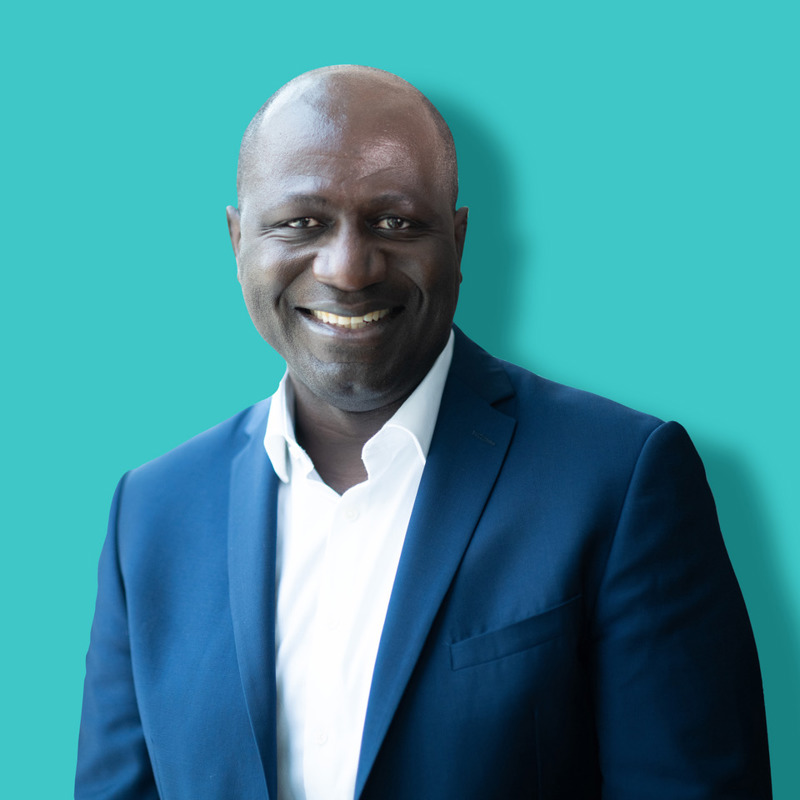Moving from goals to high-impact strategies
Increasing the impact of philanthropy involves research, testing new ideas and theories, and continuous reflection and revision of the philanthropic strategy. While not necessarily linear, the process usually includes the following components:
Development of vision, mission, and goals
The most effective philanthropy is focused on goals and outcomes. Informed by the donor’s values, goals flow from a clearly defined vision and mission that may target specific social or cultural issues, populations, or geographic areas. Whenever possible, the donor looks for tangible indicators and measures of success, while taking the long view. For example, a funder who supports economic opportunity programmes for inner-city populations might assess the impact of grants by evaluating new job creation, wage increases or career training in the target community.
Issue-focused research and analysis
Strategic philanthropy builds on best practices, identifies existing needs and gaps, and targets emerging opportunities. Through research and analysis of issues, funders can develop a critical context for determining how best to allocate philanthropic resources.
Design of the philanthropic strategy
The elements described above – values, mission, vision, goals, research, and analysis – comprise the working materials for designing a philanthropic strategy. The next step is to decide on the roles and approaches that are most likely to achieve the donor’s goals. For example, some donors pursue a strategy that fosters innovation, while other donors focus on leadership development or institutional capacity building.
Implementation
Once a donor has designed strategies and determined what role to play, it is time to implement the programme. Implementation starts with development of an action plan, timeline, and budget. The specifics of the plan will be linked to the strategies and roles the donor has chosen.
Evaluation, reflection, revision
High-impact funders continually evaluate their efforts, synthesise new research, build on effective strategies, and develop new strategies when appropriate. They engage their grantees as learning partners and seek to capture knowledge and leverage insights from their grants. These donors also seek opportunities to meet with experts, practitioners, and other funders in their field of interest, to enhance their understanding and build a network around common goals and purposes.
Increase the level of knowledge in your field of interest
Did you learn something that would be useful to other donors and nonprofit organizations? Are there findings that might influence public policy?
Make yourself more accountable
Are you exercising good stewardship of your philanthropic funds? Are you investing your money to the highest and best use?
Feel satisfied with your giving
Do you feel your gift made a difference? Your personal satisfaction will more than likely influence your enthusiasm, engagement and commitment to philanthropy. It may be that some or all of these objectives resonate with you, or that perhaps none of them precisely capture your reasons for “finding out.”
Take the time to determine your primary purposes for undertaking an evaluation. Your answer will influence the shape of the evaluation strategy.
Strategic philanthropy
TPI certainly did not invent strategic philanthropy; but when we began, the concepts and practices around it were largely exclusive to the upper echlon of major foundations and corporations. We have been determined to change this; making such strategies accessible to a growing cadre of new donors.
Today, individuals, families, foundations, and corporations hire TPI to develop and execute customised philanthropic strategies. As a thought partner, expert, or staff, we work across the continuum – from assessment to strategy development through comprehensive implementation – to help our clients reach their unique goals.

Roles donors can play beyond cheque writing
Donors can enhance their impact by thinking carefully about what roles they can and should play. In addition to grantmaking, the donor’s role may involve convening, training, media outreach, and many other tools and tactics that can enhance impact. Roles may include:
Innovator/incubator of new ideas, programmes or organisations. Philanthropy often acts as the “research and development” sector of society, generating and testing new ideas free of public sector constraints and fuelled by the creativity of the donor and grantee.
Disseminator/replicator of innovative models and best practices. When programmes and approaches are proven effective, funders can play a critical role in replicating or expanding these models and disseminating important findings and ideas.
Capacity-building of nonprofit organisations, schools, neighbourhoods and fields of interest. These donors work in close partnership with their grantees, offering technical assistance, supporting leadership development, and creating networking opportunities. “Venture philanthropy” is one term used to describe highly-engaged activity that aims to build capacity and enhance nonprofit performance.
Convener/connector. Donors can play an important role in connecting groups with common goals and interests, building coalitions and convening people around an agenda. Some donors bring together community leaders, experts, grantees, funders, and creative thinkers to generate new ideas, build consensus around a shared vision, and share experiences and best practices.
Change agent/catalyst to promote social change. Some donors address underlying causes and work to improve systems within their area of interest. They may support research, promote strategic alliances, or raise public awareness. Some donors play the role of public advocate and spokesperson to galvanise action around the issues they seek to influence.
Examples of philanthropic strategies
Just as high-impact donors think through what combination of roles will best achieve their goals, they also assess which strategies have the greatest promise to produce desired results. For example, these approaches may involve support for experimental projects, strategic partnerships with nonprofit groups or communities, or leadership development initiatives.
Below are a few strategies that can be effective, with examples that illustrate the strategy in practice. For most donors, what seems to work best is a balance of regulatory and enhancement approaches, depending on the organisation and its particular situation. For example, a regulatory approach may be appropriate for evaluating gifts to well-established organisations, while an enhancement approach may be favoured for start-up organisations or experimental pilot programs.
1. Create a new organisation
After identifying a critical need within a community or region, an experienced funder may decide to create a new entity to fill that gap. This strategy may be particularly appealing when political or bureaucratic barriers make it difficult to strengthen an existing agency or when a funder has identified emerging leaders with innovative ideas.
CREATING A NEW FORCE FOR PUBLIC SCHOOL REFORM
The directors of a family foundation agreed that the public schools in their city demanded large-scale reform. Working with two high school principals as senior advisors, the foundation launched an organisation to provide professional support and technical assistance to schools committed to educational transformation. The design of the new organisation was notable for its inclusion of key stakeholders in the planning process, including teachers, parents and students. The foundation provided half of the initial funding. After five years, this organisation was operating several networks of innovative schools, and had grown to 20 staff members and an annual budget of US$2m. It began to receive national recognition, resulting in a multi-million dollar grant from a large national foundation to expand its reach throughout the region.
2. Design a competitive grant initiative by issuing a request for proposals (RFP)
The RFP process serves as a catalyst, soliciting proposals that respond directly to the donor’s goals and interests. RFPs can stimulate innovation, encourage collaboration, bring public attention to an issue, or simply help to find the best organization to do the job.
STIMULATING INNOVATION: TRANSLATING RESEARCH INTO PRACTICE
A funder with an interest in helping adolescent girls develop self-esteem began to explore potential strategies. After discussing the issue with experts and youth program leaders, she identified a significant gap between recent research on needs of adolescent girls and the operations of many youth programmes. Based on this research, the donor issued an RFP to seed the development of innovative programme models. Over the next three years, the donor invested $3m in ten new programs designed to translate research into practice in this field. At the end of the grant period, most of these programmes demonstrated significant progress and several have attracted new funding sources to support their continued operation. Network, and Self Help Credit Union.
3. Develop an awards programme for individuals
An awards programme helps to draw public attention to an issue, while supporting individual talent and leadership.
RECOGNISING UNSUNG COMMUNITY HEROES
An anonymous donor funds an annual awards programme that celebrates unsung neighbourhood heroes and heroines. Modelled after the MacArthur “genius” awards, this programme provides three years of no-strings-attached financial support, as well as visibility, to tireless neighbourhood leaders who have been nominated by local spotters. After receiving this recognition, several honourees have received major grants from other funders for their community projects.
4. Provide support to needy and/or talented individuals
A thoughtful donor can provide critical support at the individual level, resulting in enormous impact. A young person who finds a mentor may be encouraged to pursue a college career against all expectations. An emergency loan to repair the car of a struggling single mother can make the difference between maintaining a job and becoming dependent on welfare. For a journalist, the opportunity to learn about a complex social issue may result in a series of articles that influence millions of readers. While there are some regulations governing charitable gifts to individuals, there are many ways that donors can nurture talent, enhance individual skills or give a boost to people with pressing financial needs
SUPPORTING COLLEGE ACCESS AND SUCCESS FOR TALENTED, LOW-INCOME YOUTH
A scholarship programme sponsored by one donor supports over 60 inner-city college students with financial support and mentoring. Students are identified for the program by their high school principals and teachers, and many are the first in their family to attend college. The program includes support for tuition, stipends for textbooks and computers, and access to summer internships and enrichment experiences.
5. Foster replication or adaptation of an effective model
One strategy for promoting change is to identify models that have demonstrated success and replicate or adapt these models in other communities or geographic regions.
REPLICATION OF A FAMILY LITERACY MODEL
A toy company with a strong interest in both health and education learned about a simple but effective family literacy model combining these two elements. Volunteers read to young children in the waiting rooms of paediatric clinics, and paediatricians then encourage parents to read to their children, giving them children’s books to take home. To support and expand these efforts, the company issued an RFP offering grants up to $10,000, resulting in much needed support to replication sites in communities throughout the country.
6. Launch a comprehensive “place based” transformation strategy
Some foundations target specific geographic regions or neighbourhoods and address the complex web of factors that contribute to that area’s poverty or degradation.
LONG-TERM NEIGHBORHOOD TRANSFORMATION
One foundation decided to focus on the poorest neighbourhood in their city. Over many years the foundation has supported the formation of a community development corporation and has worked closely with the local public schools to provide enrichment opportunities for children and their families. The foundation is now exploring ways to build on these efforts and support the entire “cradle to career” spectrum, including early childhood development, academic support, youth development, college access and success, and workforce development.
7. Develop a portfolio of approaches to focus on a social issue
Roles and strategies can be combined in creative ways to produce synergistic results. Funders who are deeply involved in their issue areas frequently employ several approaches that complement each other.
TACKLING FAMILY HOMELESSNESS
A foundation in Connecticut has demonstrated a sustained commitment to addressing the root causes of homelessness. The multifaceted approach has included research support, policy development, direct service grants, programme-related investments for housing units, formation of state-wide coalitions and technical assistance for grantees. Direct service grants have included housing subsidies, skills training and support for facilities serving the mentally ill. The foundation, recognising that homelessness is a complex phenomenon, works closely with professionals and policy makers in the private and nonprofit sectors, and at all levels of government.
8. Support capacity-building with selected nonprofit groups or schools
Increasingly, philanthropists recognise that institutional capacity and infrastructure are inextricably linked to the achievement of goals and outcomes. Some donors, through intensive multi-year support, help selected groups address the full spectrum of organisational issues, e.g., development of mission and goals, programme portfolio, financial systems, operations, and evaluation. Other funders address specific needs, such as using technology more effectively, strengthening fundraising capabilities or hosting conferences for experts and practitioners.
WORKFORCE DEVELOPMENT CAPACITY-BUILDING INITIATIVE
Over several years, a funder supported workforce development programmes operated by a local agency in an economically depressed region of Pennsylvania. The agency, which had demonstrated a long history of empowering low-income families and alleviating poverty, relied on government contracts. When state-wide funding cuts threatened the viability of existing programmes, the funder and the executive director discussed ways to support the agency’s overall effectiveness, particularly in the area of technology. This discussion resulted in a $75,000 grant to purchase 40 networked computers for use by 45 staff members and several hundred clients. With the new system in place, clients now have greater access to career development resources, and the staff is better equipped to individualise curricula, monitor workforce development outcomes, and provide post-employment support services.
Conclusion
Donors are most likely to achieve the greatest impact when they explicitly define their goals and choose roles and strategies that are consistent with those goals. In many respects, high-impact philanthropy relies on the qualities of successful entrepreneurs – passionate commitment, clarity of purpose, an understanding of what it will take to achieve the vision, and a combination of patience and restlessness.
Private philanthropy may be small relative to government funding, and individual grants may seem insignificant compared to the magnitude of the issue at hand; but there are examples every day of changes that lead to surprising ripple effects.
As Malcolm Gladwell says in The Tipping Point, “With the slightest push – in just the right place – [the world] can be tipped.” High impact donors seek out those tipping points and make a difference, whether they are working to create change among individuals, in local communities, or on a national or international scale. Indeed, philanthropy can accomplish a great deal, regardless of funding levels, when donors operate in smart and strategic ways.
About this guide
This guide was written by The Philanthropic Initiative (TPI), a global nonprofit philanthropic consulting practice that helps companies, foundations, families, and individuals find innovative ways to maximise the impact of their giving. TPI is a distinct operating unit of the Boston Foundation.
Download a PDF version of the original guide here.
There is also an Arabic PDF available here.


